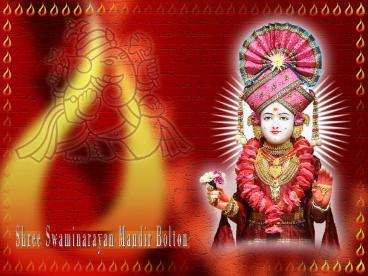SKS Swaminarayan Shikshapatri Slok 91 - PowerPoint PPT Presentation
1 / 6
Title:
SKS Swaminarayan Shikshapatri Slok 91
Description:
At appropriate times, My dveej disciples should perform rites in strict ... Nishkramana Samskara - The baby's first outing into the world, beyond the ... – PowerPoint PPT presentation
Number of Views:362
Avg rating:3.0/5.0
Title: SKS Swaminarayan Shikshapatri Slok 91
1
SKS Swaminarayan Shikshapatri Slok 91
Shree Swaminarayan Mandir Bolton
2
(No Transcript)
3
At appropriate times, My dveej disciples should
perform rites in strict adherence to the
religious scriptures and in accordance to their
own monetary capacity. These rites include the 16
purification ceremonies performed throughout a
lifetime, daily rituals and shraadh (making
ceremonial offerings to deceased ancestors or
relatives.) 91
4
- The offerings that are made to the deceased are
things like fruit, vegetables and flowers
5
16 samskaras
- . Garbhadana Samskara - is performed by a married
couple when conceiving a child. This important
Samskara raises the act of conception to a sacred
occasion, and is powerfully purifying and
uplifting for the unborn child. 2. Pumsavana
Samskara - is usually performed between the
second and fourth month of pregnancy. Its purpose
is first, to promote the birth of a male child
(for perpetuation of the family line and
tradition) second, to insure the good health of
the foetus and the proper formation of its
organs, regardless of gender. - 3. Simantonoyana Samskara - In the fourth or
fifth month of pregnancy, the mind of the foetus
begins to develop. This is when simantonoyana
Samskara is performed. Its purpose is to protect
the foetusespecially its newly forming mindfrom
all negative influences, and also to stimulate
the development of the unborn childs
intellect.4. Jatakarma Samskara is the ritual
performed at the birth of a child. It awakens the
childs intellect, gives it strength, and
promotes long life for the child. 5. Namakarana
Samskara - On the eleventh day after the childs
birth, namakarana Samskara is performed. In this
ceremony, the child receives its name. - 6. Nishkramana Samskara - The babys first outing
into the world, beyond the confines of the home,
is the occasion of nishkramana Samskara7.
Annaprashana - The first feeding of solid food to
the baby, usually in the sixth month after birth,
is the occasion of Annaprashana Samskara8.
Karnavedha Samskara - usually performed in the
sixth or seventh month after birth, consists of
the piercing of the babys ear lobes, so earrings
may be worn.
6
16 samskaras
- 9. Chudakarana Samskara - At the end of the first
year after birth, or during the third year, the
childs hair is shavedall but a tuft on the top
of the head. This ritual shaving of hair,
performed with ceremony, prayers, and chanting of
Vedic hymns, is chudakarana Samskara This
Samskara is for both boys and girls.10.
Vidyarambha Samskara - begins a students primary
education by ceremonially introducing the child
to the alphabet 11. Upanayana Samskara -
initiates the formal study of the Vedas. It is
one of the most important and esteemed of the
samskaras. Upon performance of Upanayana, a boy
traditionally moves from home to live in the
ashram of the guru. - 12. Samavartana Samskara - With samavartana
Samskara the disciple graduates from his Vedic
studies and returns from the house of his guru.
Thereafter, the disciple will marry and raise a
family, and so enter the stage of householder,
grihasthashrama. 13. Vivaha Samskara - The
traditional Hindu wedding ceremony is known as
vivaha Samskara It is considered by many to be
the most important of all the samskaras. - 14. Panchamahayagna Samskara - A married couple
performs the panchamahayajna, or five great
sacrifices, daily. In this Samskara, one honours,
in turn, the rishis (ancient seers of Truth), the
gods, the ancestors, humankind, and all created
beings. - 15. Vanaprastha Samskara - According to the Vedic
tradition, vanaprastha is the third stage of
life, following brahmacharya (Vedic
student/disciple) and grihasta (householder).
Here, a man leaves behind his life in the world
and retires to the forest (with or without his
wife), to live an ascetic life devoted to study
of the scriptures and to meditation.16.
Antyeshti Samskara - The final sacrament, the
funeral rites, are known as antyeshti Samskara































